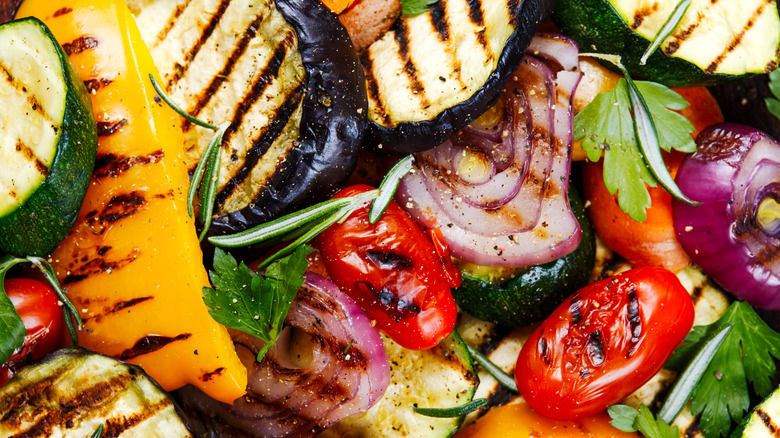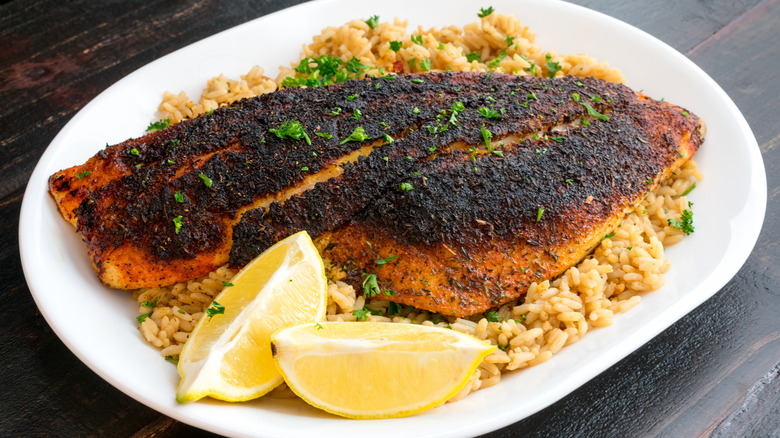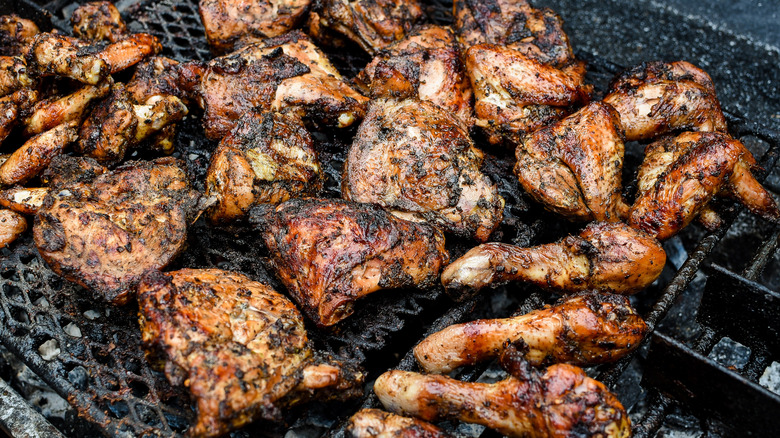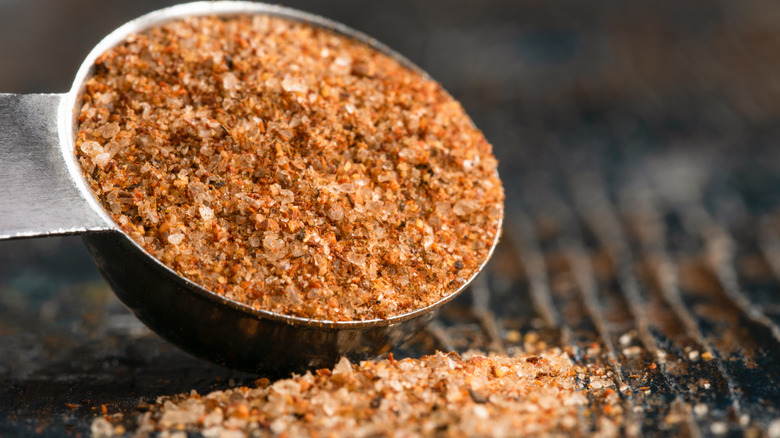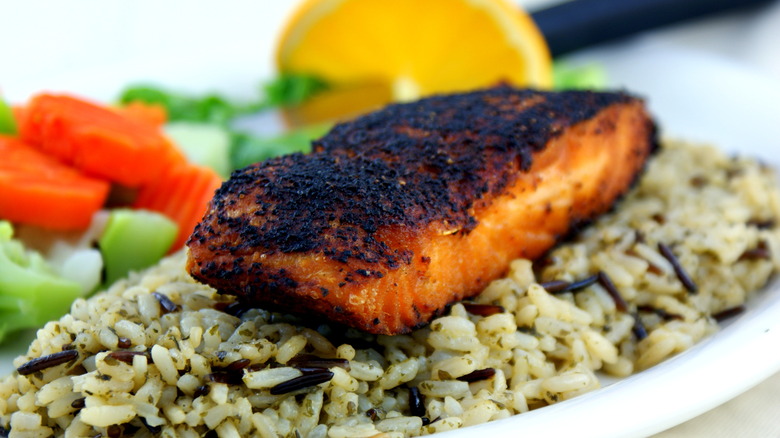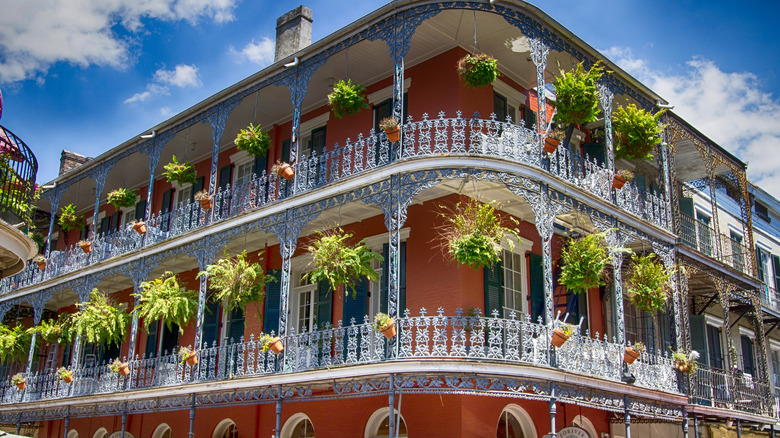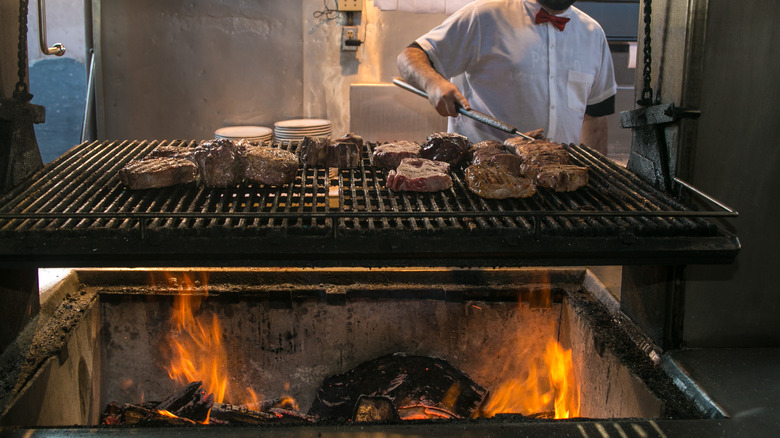The Clear Difference Between Blackened And Charred Foods
The sight of black marks and charring on the edges of your food, whether it be the ends of your brisket or the crust of a Neapolitan pizza, is one of the most enticing sights in eating. Some people might see that and think burnt, but those who know understand that a little black on your food often means flavor — not a kitchen mistake. Chefs know that better than most, and cuisines around the world have developed methods and recipes for getting that perfect singe on food without outright burning it, all in search of the magic that a little char can bring to meat, fish, and vegetables.
You might think that blackening and charring are two cooking terms that can be used interchangeably, but in the world of food, nothing is ever that simple and there are some pretty big differences between the two types of cooking. Charred food is a more general cooking term, while blackened food refers to a specific type of recipe that was more recently developed in the United States.
At the most fundamental level, any time you use heat and the Maillard reaction to add some deep-brown or black coloring to your food in any capacity, you're charring it. Blackening does this too, but revolves around additional spices and other ingredients to give a meal a more unique flavor.
What is blackened food?
Blackening as a technique came out of the world of Cajun and Creole cooking in Louisiana and first became popular in the 1980s. Its genesis is credited to chef Paul Prudhomme, who created a blackened redfish at his New Orleans restaurant, K Paul's. The original recipe involved dipping a fish filet in butter, coating it with a spice mixture, and searing it in a hot cast iron skillet. It was created to mimic the flavor of live-fire charcoal grilling on a stovetop since Prudhomme didn't have access to a grill at his restaurant. The redfish became a national sensation, with food media covering the craze, and demand so high that it caused a temporary fishing ban in the Gulf of Mexico.
These days blackening can be done with all kinds of fish, meat, or vegetables, but the method is still almost identical to Prudhomme's. Cover the food in butter, rub with spices, and cook over high heat until the eponymous black crust forms. The spice mix can vary, but is very similar to most Cajun seasoning mixes, and includes cayenne and paprika, onion and garlic powder, and dried herbs like thyme and oregano. Without some kind of similar spice mix, it's not blacked, no matter the color. It's not burnt either but gets its dark color from the cooking of the milk solids in the butter with the spices. That combo also creates the essential "crust" of spices that adds texture to the dish.
What is charred food?
Like blackening, charring is a technique that can be applied to different foods, but it's much more basic. Charring is simply the act of deliberately adding a small amount of burnt flavor to your food anywhere you can generate enough heat, from a grill to a wok to your oven's broiler. It doesn't require any extra ingredients; it just comes from applying high heat to your food. Charring is distinguished from burning food in both scope and intention. Burning food means accidentally applying heat too long until your dish is carbonized, which adds bitter flavors that can make it inedible. Technically, charring is also burning, but done in small amounts in a controlled fashion. Food is charred when we want to deliberately add pungent flavors as a contrast to other elements of a dish. A classic example is crème brûlée, where the top of the custard is charred to balance the sweetness.
Charring works in a similar fashion to the Maillard reaction, which we also think of as browning. The Maillard reaction happens when heat interacts with proteins and sugars, changing their chemical properties and creating new and more complex flavors in your food. Charring is just a continuation of that process that adds even more depth to food and creates new flavors that are smoky and caramelized.
Blackening uses a spice mix and butter
Blackening makes use of charring, and it shares a burnt appearance with many charred dishes but is set apart by the spice and butter combination that forms the basis of its use in any recipe. The butter is just as important as the spices because the blackened color comes from the cooking of the spices in the milk solids. The fat of the butter prevents the spices from getting too bitter and unlocks more depth of flavor, similar to how you might bloom spices in hot oil when cooking. It's that unique alchemy of heat, spice, and fat that makes a dish blackened.
Charring on the other hand doesn't need, or refer to, the use of any specific ingredients; any dish can be charred if you cook it over high enough heat, although you might not always want to do that. It's a chemical reaction and a tool for bringing out flavor. Charring is essential to plenty of recipes, including blackened food, but it's usually complimentary to the central ingredients that define the dish.
Blackening adds a rich, spicy flavor and crunchy texture
Because blackening always uses some kind of Cajun or Creole spice blend, it imparts a specific warm, smoky flavor to food. Blackened food isn't supposed to be "burn your tongue" spicy, but it has a distinct earthy heat to it from the way the cayenne, paprika, and herbs get cooked in the butter. That cooked butter, which is also sometimes drizzled over the finished dish, brings an extra hint of richness that compliments the savory spiced taste. Charring does have a taste of its own, but it's primarily a way of bringing out more flavor from the ingredients you already have. The impact charring can have on flavor will vary greatly depending on the dish, and can even bring out sweetness in things like tomatoes or Brussels sprouts.
Another defining feature of blackened food is the texture. The generous spice rub acts as a coating, forming a thin, crispy crust over the exterior of the food as it's fried in the butter. That crust creates a nice contrast with the tender meat or fish on the inside. Charring can also be used to add some texture, like when you are searing a steak, but it's not usually the purpose of the technique. Plenty of charred foods like fruit and vegetables won't have any crunch at all.
Blackening is Cajun and Creole-inspired
Blackened food was not a traditional Louisiana dish before it was created by Prudhomme, but its popularity helped push awareness of Cajun ingredients and New Orleans Creole cooking into the mainstream. The blackened spice mixes you can buy, including Prudhomme's, are very similar to Creole and Cajon seasonings, which came from New Orleans and Louisana's unique immigrant history. Even the flavor profile of blackened food echoes other tastes in Louisiana cooking. Its smoky flavor is reminiscent of dark roux, which is commonly used in dishes like gumbo and étouffée. Dark roux has a nutty and toasty flavor that it imparts to dishes, and while it's not spicy by itself, combined with other seasonings in those dishes, it creates a distinctly Louisiana flavor that comes from the same family as blackening.
Blackening was also first developed as a way to cook fresh Gulf Coast seafood — an essential staple of Louisiana cooking. The bitter, spiced flavor of blackened food is a great contrast to mild, lightly sweet fish, and with waters full of catfish, grouper, red snapper, and shrimp, there is no shortage of that in New Orleans.
Charring is a world wide cooking technique
Charred food casts a much wider net than the Louisiana-born blackening. As a way to add big tastes to food, it has been embraced in cuisines from India to South America. Part of the reason charring can be seen in so many cuisines is that it's a great way to add depth of flavor without any extra ingredients, which is useful for people with limited resources. There is also the universal experience of cooking over a live fire, which has been done by many cultures and their ancestors all over the globe. You don't need a fire to char food, but it is the best way and creates tons of chemical interactions that make even simple foods much more complex. The taste of charring is the taste of fire, and that's something every cuisine has a connection to.
You can see charring's popularity in plenty of classic dishes. It's used in Mexico to add flavor to tomatillos and tomatoes for salsa, or when making Middle Eastern kabobs and shawarma. Even simple American favorites like grilled corn on the cob of a smashed hamburger lean on charring to develop a lot of their flavor. The most obvious use of charring happens in barbecue. Many regions have some form of local barbecue, like Peri Peri in Southern Africa, or H'mong barbecue in Southeast Asia, and they all make use of flame-kissed flavors and charring.
